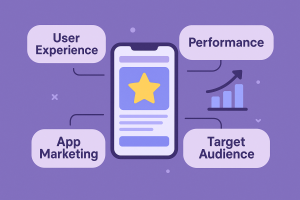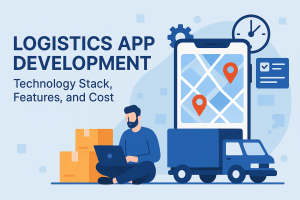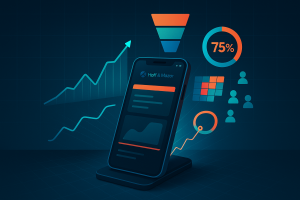Mobile app development might seem complicated, but it’s actually easier to learn than you think. This guide is for beginners who want to create their own apps for phones and tablets. You will find helpful tips, tools, and steps to get started. Whether you dream of making games or tools, this article will help you understand the basics of app development. Let’s jump in and see how you can bring your app ideas to life!
Table of Contents
ToggleWhat is Mobile Application Development?
Mobile application development includes various components like front-end and back-end development. On the front-end, design experts create the user interface (UI), focusing on visual elements that appear on the mobile device’s home screen. This involves using programming languages like HTML5, CSS, and JavaScript to build native apps for the Android and iOS platforms.
On the back-end, developers work with databases and APIs to manage data access, ensuring users receive relevant information quickly. Frameworks such as Flutter or PhoneGap facilitate hybrid apps, allowing cross-platform code to run on both operating systems. The development process can vary, using agile methodologies or other strategies to fit project needs and budget. Skills in software development are important, along with familiarity with GraphQL for data queries or SDKs for app features like notifications.
Developers may also implement Progressive Web Applications (PWAs) for a mobile-like experience in web applications.
Choosing a Platform for Mobile Apps
When selecting a platform for mobile app development, it’s important to consider business goals, budget, and target audience. Different platforms offer various capabilities like data access and user interface options.
For example, native mobile applications often provide better performance and user experience, appealing to specific demographics. Comparing native, hybrid, and cross-platform apps reveals that native apps typically use programming languages like Swift or Java, while hybrid apps might incorporate HTML5, CSS, and JavaScript. Cross-platform development allows code to be reused across devices, which can lower costs. The choice of operating system, such as iOS or Android, also impacts design, as different systems have distinct user interface guidelines. Design experts frequently focus on mobile UI design to enhance user experiences through visual elements.
Developing for Both Android and iOS: Native vs Hybrid Apps
Native app development centers on creating applications tailored for a single operating system, like Android or iOS, using programming languages such as Kotlin or Swift. On the other hand, hybrid apps, developed with frameworks like PhoneGap or Flutter, operate across various platforms by integrating web technologies like HTML5, CSS, and JavaScript.
This approach can streamline app development cost and time since developers write cross-platform code, but may lead to performance issues compared to native apps, which offer superior speed and responsiveness. The user experience often benefits in native apps due to better access to device features, such as notifications and back-end user data, which enhance user engagement. Developers should weigh factors like budget, project timeline, and the desired user experience when choosing between native and hybrid approaches.
The implementation of APIs and back-end databases also influences how easily data can be accessed, with native applications generally enjoying optimized access to system resources. In terms of mobile UI design, native apps typically offer a more visually appealing and responsive user interface, while hybrid apps can still provide satisfactory experiences through effective frameworks and design practices.
Optimizing for Mobile Platforms
Developers can ensure a positive user experience on mobile applications by focusing on mobile UI design that adapts to various screen sizes and devices. This involves frameworks like Flutter and PhoneGap, which allow for cross-platform apps that function well on both Android and iOS platforms.
To enhance performance and loading times, developers should reduce the size of images and scripts and optimize APIs for faster back-end data access, including tools like GraphQL for efficient data retrieval. Strategies such as implementing notifications can keep users engaged without slowing down the mobile app. Responsive design techniques, such as employing CSS and HTML5, can help create layouts that adjust smoothly on different screens, improving usability. By prioritizing backend integration and ensuring data sources are quickly accessible, developers can maintain a seamless user experience.
Testing on real mobile devices helps identify issues in the user interface and design, making it easier to spot areas for improvement. This combination of strategies leads to effective app development that meets user expectations.
Utilizing Cloud for Mobile App Development
Enhancing Your App with Cloud Services
Cloud services significantly enhance the scalability and performance of mobile applications by allowing developers to adjust resources easily.
For example, if a mobile app experiences a surge in users during a sale event, cloud services can quickly provide additional computing power, ensuring smooth operation. Integrating cloud-based storage improves user experience by enabling seamless access to data across multiple devices. Users can save their preferences and information in the cloud, facilitating easy retrieval from various mobile devices, including those on iOS or Android. Security is also a major consideration; developers must implement data encryption and secure APIs to safeguard sensitive information. Weak security measures can lead to data breaches and loss of user trust. Programming languages like JavaScript or frameworks like Flutter simplify mobile app development with effective cloud integration, resulting in an improved user interface and experience.
By employing back-end databases and strategies like hybrid apps or progressive web applications, developers can create solutions that are both efficient and user-friendly for their mobile applications.
Joining Developer Programs for Support
When selecting a developer program for mobile application development support, factors like access to technical assistance, availability of training resources, and programming language compatibility, such as JavaScript or CSS, should be taken into account. Engaging in a developer program allows for connections with design experts who provide user interface and user experience feedback, leading to enhanced mobile applications.
Additionally, developers can access APIs and SDKs that simplify backend data access. Many programs offer tools, including frameworks for cross-platform app creation and hybrid app development with technologies like Flutter or PhoneGap. Resources may encompass detailed documentation, sample code, and community forums for sharing solutions to common challenges.
Whether focusing on iOS or Android, these programs support a better grasp of mobile UI design and data sources, empowering developers to build attractive native mobile applications and web applications withengaging notifications and a visually appealing home screen experience.
Resources for Mobile Application Development
Developers aspiring to improve their capabilities in mobile app development have an array of resources at their disposal. Online courses offer instruction in programming languages such as JavaScript, CSS, and HTML5, while frameworks like Flutter and PhoneGap assist in efficiently creating mobile applications. For back-end development, developers can access databases and APIs, enhancing data retrieval and notifications.
Data sources and tools are easily found by visiting platforms focused on software development that detail various mobile app frameworks.
Online communities and forums provide valuable connections between developers and design professionals, fostering support through conversations about user experience and mobile UI design. These platforms enable the exchange of insights on different operating systems, including iOS and Android, as well as techniques for mobile front-end development. Hybrid cloud technologies offer guidance on effective cross-platform app creation, allowing for the development of both native applications and progressive web apps that function smoothly on multiple devices. An appropriate budget can inform the selection of services and tools, ensuring the creation of visually appealing applications for mobile device home screens.
Related Solutions in Mobile Development
Frameworks like Flutter and PhoneGap, along with programming languages such as JavaScript, HTML5, and CSS, are popular in mobile application development. These tools assist developers in creating both native and hybrid apps efficiently. Cross-platform development tools allow the use of one codebase for multiple operating systems, which can lower costs and speed up production compared to traditional native development.
While native applications may offer better performance and user experience ona specific operating system, cross-platform apps can reach a wider audience more quickly.
Integrating third-party APIs can enhance mobile applications by providing easy access to data sources or services. This enables developers to add features like notifications or user authentication without starting from scratch.
For example, employing an API might help connect a mobile app to a back-end database or facilitate communication with a hybrid cloud service. Design experts often emphasize mobile UI design to improve user interface, ensuring the app is visually appealing while offering a seamless user experience. Thus, the combination of various advancements shapes the development of mobile apps on devices like iOS and Android.
Key takeaways
Mobile app development involves creating software applications for mobile devices like smartphones and tablets. This process typically includes several stages: planning, design, development, testing, and deployment.
In the planning phase, developers identify the app’s core purpose and target audience. This stage often incorporates market research to understand user needs and existing competitors.
Design focuses on user experience (UX) and user interface. Effective design enhances usability and aesthetic appeal, which can significantly impact user retention.
Development consists of writing the application’s code, which can be performed using various programming languages and frameworks. Common languages include Java, Swift, and Kotlin, while popular frameworks include React Native and Flutter.
Testing ensures the app functions correctly and meets quality standards. This stage includes various testing methods, such as unit tests, integration tests, and user testing.
Once testing is complete, the app is deployed to platforms like the Apple App Store and Google Play Store. After launch, developers often engage in maintenance and updates to improve functionality and user experience based on feedback.
Understanding legal considerations, such as copyright, privacy laws, and app store guidelines, is also important in mobile app development. Additionally, marketing strategies should be considered to effectively reach the intended audience and drive downloads.
FAQ
What are the basic steps involved in mobile app development?
The basic steps in mobile app development are: 1) Define the app idea and target audience; 2) Design wireframes for the interface; 3) Develop the app using appropriate technologies (e.g., Swift for iOS, Kotlin for Android); 4) Test the app for bugs; 5) Launch it in app stores; 6) Gather user feedback for improvements.
What programming languages should I learn for mobile app development?
For mobile app development, learn Swift for iOS and Kotlin for Android. Additionally, consider JavaScript with frameworks like React Native or Flutter for cross-platform development. These languages will help you build effective and responsive mobile applications.
How do I choose between native and cross-platform app development?
Choose native if you need high performance, device-specific features (e.g., augmented reality apps). Opt for cross-platform for faster development and broader reach (e.g., apps targeting both iOS and Android users). Evaluate your budget, timeline, and target audience to make an informed decision.
What tools and software are recommended for beginners in mobile app development?
Recommended tools for beginners in mobile app development include Flutter for cross-platform apps, Android Studio for Android development, and Xcode for iOS. For no-code options, consider frameworks like Adalo or Thunkable. Additionally, GitHub is great for version control.
How can I test and deploy my mobile app effectively?
Conduct thorough testing using tools like TestFlight for iOS and Google Play Console for Android. Implement automated testing with frameworks like Appium. Gather user feedback through beta testers, then deploy updates regularly based on insights and performance metrics to enhance user experience.







